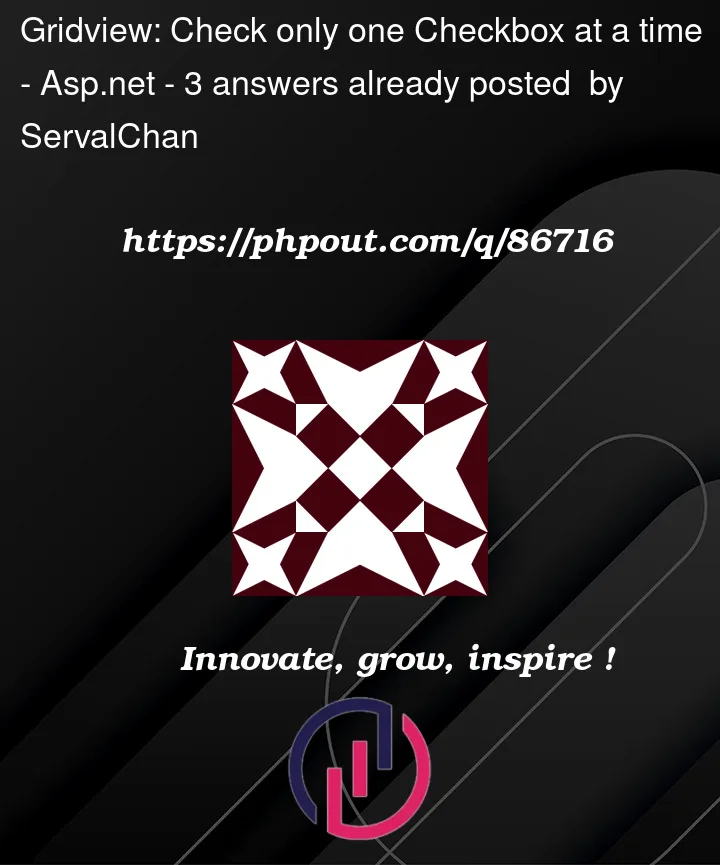Context:
I have a gridview with checkboxes on each row. The user is able to select a row by checking a checkbox in order to submit that info and progress through the app.
Question:
Is it possible to have it where only one checkbox is able to be checked at a time and when another checkbox is selected, all other checkboxes are unchecked?
Aspx:
<asp:GridView ID="GVSelect" runat="server"
AutoGenerateColumns="False" DataKeyNames="ID" AllowPaging="True" BackColor="White" BorderColor="#CC9966" BorderStyle="None" BorderWidth="1px" CellPadding="4" OnPageIndexChanging="GvSelect_PageIndexChanging" DataSourceID="SqlDataSource1" ShowHeaderWhenEmpty="True">
<Columns>
<asp:BoundField DataField="ID" HeaderText="ID" SortExpression="ID" ReadOnly="True" Visible="False">
<HeaderStyle HorizontalAlign="Center" VerticalAlign="Middle" Wrap="False" Width="100px" />
<ItemStyle HorizontalAlign="Center" />
</asp:BoundField>
<asp:BoundField DataField="Column 1" HeaderText="Column 1" SortExpression="Column 1" ReadOnly="True">
<HeaderStyle HorizontalAlign="Center" VerticalAlign="Middle" Wrap="False" Width="100px" />
<ItemStyle HorizontalAlign="Center" />
</asp:BoundField>
<asp:BoundField DataField="Column 2" HeaderText="Column 2" SortExpression="Column 2" ReadOnly="False" DataFormatString="{0:yyyy/MM/dd}">
<ControlStyle Width="90px" />
<FooterStyle HorizontalAlign="Center" />
<HeaderStyle HorizontalAlign="Center" VerticalAlign="Middle" Width="100px" />
<ItemStyle HorizontalAlign="Center" Width="90px" Wrap="False" />
</asp:BoundField>
<ItemTemplate>
<asp:CheckBox ID="chkSel" runat="server" AutoPostBack="true" OnCheckedChanged="chkSel_CheckedChanged" />
</ItemTemplate>
<ControlStyle Width="50px" />
<FooterStyle Width="75px" />
<HeaderStyle HorizontalAlign="Center" VerticalAlign="Middle" />
<ItemStyle HorizontalAlign="Center"></ItemStyle>
</asp:TemplateField>
<asp:CommandField ShowEditButton="True">
<HeaderStyle HorizontalAlign="Center" VerticalAlign="Middle" Width="50px" />
<ItemStyle HorizontalAlign="Center" BorderWidth="1px" Height="5px" VerticalAlign="Middle" Width="5px" />
</asp:CommandField>
</Columns>
aspx.cs:
protected void chkSel_CheckedChanged(object sender, EventArgs e)
{
int rowind = ((GridViewRow)(sender as Control).NamingContainer).RowIndex;
CheckBox cb = (CheckBox)GvSelect.Rows[rowind].FindControl("chkSel");
if (cb.Checked == true)
{
lblOne.Text = GvSelect.Rows[rowind].Cells[1].Text;
lblTwo.Text = GvSelect.Rows[rowind].Cells[2].Text;
}
else
{
lblOne.Text = "";
lblTwo.Text = "";
}
}




3
Answers
Depending on how many checkboxes you are going to have it may just be easier to have a list or array of boolean values. Where everytime you check a box you deselect all of the others.
This is not the most ideal solution however there is no built in behavior for this that I am aware of so it may be your best option.
Give it a try and let me know how it goes.
You can try to add an event on your checkbox, like :
https://learn.microsoft.com/fr-fr/dotnet/api/system.web.ui.webcontrols.checkbox.oncheckedchanged?view=netframework-4.8
Ok, you have two ways to do this.
You can use server side code – that will cause a post-back. Often not the end of the world, but do keep this in mind.
So, say with this grid view:
Note how we drop in a simple plain jane check box. And note the auto post back, and the event stub.
So, to load the grid, say this:
And we now have this:
Ok, now our check box event, it can be like this:
So, above, code behind – with post back.
But, you can quite easy do this 100% client side – javaScript.
So, drop the code behind, and write quite much what amounts to the SAME code, but this time in JavaScript.
So, remove auto-post back, and the event from the the check box – but now use a client side click, say like this:
and right below the GV, this script:
So, both really do the same logic. but, the 2nd example does not require server side code.